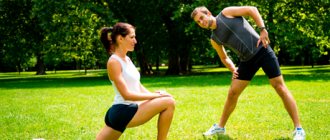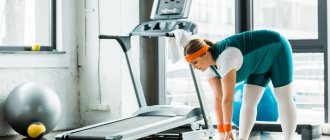© AndrewLozovyi — depositphotos.com
Share:
Not all beginners understand that warming up before training is an integral part of the training process. By taking this rule as a basis, you will protect yourself from many unnecessary injuries, maintain athletic longevity and increase the benefits of working out in the gym. In this article we will figure out how to properly warm up before training and why it is necessary.
Why do you need to invigorate your body?
Warm-up exercises before training are usually skipped by the vast majority of athletes, approximately 5% of them use them to prepare their body for stress. The reason for this is simple - at first glance, it seems that warming up does not help build muscle mass or lose weight, which is why it is perceived as an unnecessary element of the workout.
This approach is fundamentally wrong, according to experienced trainers and fitness instructors, since an unprepared body does not respond so well to the loads offered during training. It is enough to use such exercises just a few times before the main task program, and you will immediately notice the difference; the productivity of your trips to the gym will increase significantly.
Fitness program
The fitness program is recommended for those categories of girls who plan to regularly visit the gym for gradual training of all muscle groups.
Trainers recommend starting training with programs that are aimed at influencing several muscle groups, gradually increasing their number; the most common training methods are for women who cannot regularly allocate the necessary time to go to the gym.
First day:
| Exercises | Number of times and approaches |
| Squats | 20 times |
| Lunges with weights | 8 times on each leg |
| Dumbbell Belt Press | 10 times |
| Abdominal swing on a bench | 10 times |
Second day:
| Exercises | Number of times and approaches |
| Raising the barbell to the waist | 8 times |
| Close grip pull-up | 5 times |
| Squat with weights | 10 times |
| Exercise book | 10 times |
The third day:
| Exercises | Number of times and approaches |
| Deadlift | 10 times |
| Romanian deadlift | 10 times |
| Pulling the block to the belt | 15 times |
| Bench press with dumbbells | 10 times |
| Dumbbell raises | 10 times |
Before each start of a lesson, it is necessary to warm up. Each woman can independently create an exercise program that is most suitable for her body and adhere to it.
What are the benefits of warming up?
To achieve the greatest effect from your workouts, you need to not only know how to do a warm-up correctly, but also understand its intricacies. Warm-up exercises mobilize ligaments and joints, and also activate muscle function, so sometimes they are performed not only before the start of classes, but also after. With their help, it is also possible to significantly increase the blood supply to the muscles, which has a positive effect on the general condition of the body.
The advantages of warming up also include the prevention of possible injuries that may occur when working with certain exercise equipment, the release of adrenaline, acceleration of metabolism, improvement of the functioning of the nervous system and impulses, as well as the emergence of a general mood for training.
Consequences of neglecting warm-up
For clarity, let's compare the human body to a car.
Imagine you got into a car without pre-warming it and immediately pressed the gas pedal to the floor.
The engine (our heart) choke from sudden overload, all the rubbing parts (joints and ligaments) work with squealing and creaking, smoke comes out from under the wheels (muscles). It's a pity for the car, isn't it? And it’s unlikely that any of you use this style of driving.
But for some reason, many visitors to fitness clubs do not spare their bodies. And they often start training, forgetting about the warm-up exercises.
Remember:
Warming up before training is an essential part of the training process.
Failure to comply with this rule leads to accelerated wear and tear of the heart. After all, the myocardium is a striated muscle, the same as the skeletal muscles that you are trying to strengthen. Therefore, it also needs to be warmed up before loading.
Training for “cold” muscles is a 100% guarantee of injury.
Usually the ligaments and tendons are damaged, and a little less often – joints or muscle fibers. Moreover, in order to get injured, you do not have to be a professional athlete or lift heavy weights.
If the muscles or ligaments are not warmed up, injury can occur out of the blue, even when lifting an empty bar.
Is there an ideal set of exercises?
At first glance, a universal pre-workout warm-up may be a panacea for everyone who wants to spend time in the gym effectively, but in fact it does not exist. The reason for this is quite simple - each person has his own physiological characteristics, due to which certain exercises may simply not be suitable for him.
In addition, before starting warm-up tasks, you need to clearly formulate their purpose. What you get in the end - warming up the whole body or just certain muscles - will depend on your desire and on the set of basic exercises that you have planned to perform on the day of training. Once you have decided what you need a warm-up for, you will need to choose one of its 4 varieties.
There are three main types of it:
General
– exercises that warm up the entire body as a whole.
Special
– working out a specific muscle group so that subsequent impacts on it will bring maximum results. Usually very similar to the main exercises from the workout.
Stretching
– helps to achieve greater elasticity and mobility of the body.
The general type is considered the most universal. If you are not sure what kind of warm-up you need, choose it, and you won’t go wrong.
What types of warm-ups can you use?
If you recently came to the gym and still don’t know how to warm up before a workout correctly, the best option would be to use a general warm-up, during which you prepare your whole body for the upcoming loads. When done correctly, you can activate your own metabolism and help your muscles receive an additional dose of oxygen.
The duration of such a warm-up is 10-15 minutes, it will directly depend on the physical fitness of the athlete. The general set of warm-up exercises includes light running, tasks for joint flexibility, jumping rope, as well as tasks aimed at warming up the muscles of the legs and arms.
More experienced athletes can use a warm-up, which simulates working with heavy equipment. Its main difference is that here the working weights do not exceed 10-15% of the maximum possible. Warm-up exercises are performed before each main task; 10 repetitions will be enough. This warm-up is aimed at helping the body remember how to perform certain exercises correctly.
Here is a selection of ready-made warm-ups:
Below you will find several options for how to properly warm up before strength training and other workouts using the example of 5 complexes for warming up muscles.
Universal
A universal warm-up is suitable for preparing for any type of physical activity, be it simple physical education, a fitness program for practicing at home, or working with iron in the gym. Perform each movement for 10 seconds and move on to the next.
Fast
Do each movement for 20 seconds.
Classical
Repeat each exercise 10 times.
2 minute
Repeat each exercise for 10 seconds.
4 minute
Do each exercise for 20 seconds.
Fighting
Perform each movement for 30 seconds.
How to properly complete a workout?
To achieve the maximum effect from working in the gym, you need to know everything about how to warm up not only before completing the main set of tasks, but also after it. A cool-down will help in this matter - a post-workout set of exercises that will help the body calm down and realize that all the work with the exercise equipment planned for today has been completed.
It will take no more than 10 minutes to complete; acceptable exercises here include slow running or walking at an average pace; you can also use slow stretches in different directions. With a cool-down, your body can quickly rid your muscles of lactic acid, calm your heart rate, and normalize muscle blood flow.
Some athletes believe that they can do without a cool-down, but this is far from true. If you stop training suddenly, blood will begin to accumulate in the intramuscular veins, which will lead to a surge in pressure. The heart will be forced to increase the pace of its work in order to pass through itself the required amount of stagnant blood and to normalize the blood flow of the muscles, which is not at all beneficial for it.
Basics of women's training
Regular strength exercises allow you to achieve the necessary results; you should not think that strength training can turn a woman’s figure into a masculine look. This is practically impossible, since a large number of distinctive features between the physiology of men and women eliminate this type of problem.
Women's training has its own basic principles, which include the following points:
- Any type of exercise should consist of several stages, this is, first of all, a warm-up for muscle tissue, basic exercises, and a testamentary warm-up.
- Time is allocated for cardio exercise.
- During physical activity, exercises for all types of muscles should be performed.
- Correctly completed tasks enhance the results obtained.
- Classes are held even on menstrual days, but with less intensity.
- The most optimal training time is one hour.
- It is recommended to visit the training room every other day.
Following these simple rules allows you to achieve your goals much faster and maintain the results.
How to prepare your joints for training?
It's not enough to just know how to warm up before a workout, you also need to understand what exercises you can use on your joints to minimize the risk of injury. This is especially important for those who spend most of their working time at the computer; they simply cannot do without preparing their wrists for exercises.
If you plan to bench press, first do a few push-ups on your knees, doing them slowly and gradually increasing the load on your wrists. It is imperative to stretch your shoulder joints, for this you can use circular movements with your arms, horizontal push-ups are also suitable, all this will help your body prepare for an intense workout.
Benefit
Why do we need to stretch at all? Regular stretching has many benefits:
- reduces muscle tension and makes the body relax;
- helps increase muscle strength and, as a result, accelerate their growth , since muscle strength directly depends on the amplitude of its contraction. Those. The greater the difference between the long muscle in a relaxed and contracted state, the stronger the muscle. The only way to increase the amplitude of contraction is to make the muscles more elastic so that they can stretch more. This is why stretching exercises help increase strength;
- develops coordination, allows you to move more freely and easily;
- expands the range of available movements;
- helps maintain the flexibility of your body and prevents a decrease in joint mobility, because physiologically the body is designed in such a way that over time the elasticity of the muscles decreases if they are not stretched;
- helps to weaken mental control over the body, which begins to move “on its own”, and not at the command of your Self or obeying the competitive instinct;
- provides good health.
Stretching and warming up before exercise: what's the difference?
In most cases, beginning athletes consider warming up and stretching to be the same thing, but in fact we are talking about two completely different methods of working in the gym. Warm-up should prepare the entire body to perform basic tasks, but stretching should stretch all muscle groups so that they receive a sufficient amount of oxygen and nutrients. It is recommended to perform warm-up exercises first, and only then can you begin stretching, otherwise there is a risk of injury.
Stretching is divided into three types: ballistic, dynamic and statistical. The first is a series of fast movements of a chaotic type, with the second you need to slowly repeat future complex exercises, and with the third you need to fix the limbs in a certain position and consciously strain them.
According to experienced trainers, dynamic stretching has the most effective effect on the body, but it is used very rarely, preferring random arm rotations. Not long ago, a new type of similar exercise appeared in the West - plyometrics, which implies that all exercises are performed with your own body weight. Despite the fact that it simultaneously increases muscles and warms them up, trainers are still quite skeptical about it, considering it a fashion trend.
Mistakes made when warming up
- Warm-up takes too little time ; often, 1-2 minutes is not enough to properly warm up the muscles and joints.
- Only the part of the body that the athlete will load according to plan is warmed up , for example, the shoulder girdle. But in vain, regardless of the complex, you need to warm up the whole body.
- Warm-up begins with stretching, sharp swings or twisting , and this is very dangerous. Start with cardio, only then do joint exercises and muscle stretching.
- A warm-up is considered to be the first warm-up approach with a light weight. This has already been said, this is an incomplete warm-up; muscles or joints will quickly get injured from this method.
Where to start preparing?
The pre-workout warm-up can start from top to bottom, and the first stage will be working on the neck muscles. For the first exercise, you will need to stand up straight, straighten your shoulders, and then press your chin to your chest and hold in this position for about 3 seconds. It is important that you feel the back of your neck gradually stretch, this will mean that you have achieved results.
There is an alternative option, for it you will need to place your feet shoulder-width apart, your position should be as stable as possible. Turn your neck to one side so that your chin is always at the same level. Reach the highest possible position, then return to the starting position and rotate your neck in the opposite direction. To obtain the desired effect, you must perform up to 10 repetitions.
We must not forget about the trapezius muscle. For the starting position, you will need to grab your head with your right hand, and then very carefully lower it onto your shoulder until it works. Lock in this position for 5-7 seconds, and then return to the starting position, then repeat the exercise 6-7 times. Next, you will need to change your hand and complete the task in a similar way.
Exercises in the gym for the back
To obtain uniform relief throughout all parts of the body, it is necessary to perform exercises for the back. To train your back, basic exercises that need to be included in the general training program are quite complete.
You can use the following program for the back:
| Exercises | Number of times and approaches |
| Horizontal block row behind the head | 2 sets of 8 times |
| Hyperextension | 2 sets of 10 times |
| Deadlift | 3 sets of 8 times |
| Push-ups | 15 times |
| Pull-up | 2 sets of 5 times |
| Plank | at least one minute |
| Barbell chest press | 3 to 5 times |
To train your back, you need to periodically change or add exercises; this is necessary for a more visible result and to prevent incomplete training.
What will be important for guys?
Warm-up for men before training must necessarily include exercises for the pectoral muscles, since they are the subject of adoration of representatives of the opposite sex. To complete one of the tasks you will need to approach a vertical support; you can use a wall for this. Place your arm on the support, bending it at a right angle, then, without lifting it, lean forward until you feel your pectoral muscles tighten. You will need to stay in this position for 5-6 seconds, then return to the starting position and repeat the task, but with the opposite hand. 5-6 repetitions will be enough.
There is an alternative option - you will need to stand up straight, after which you need to form a lock behind your back with your hands and gradually begin to pull it back. It is advisable to slightly raise the resulting lock up so that your arms remain straight. If everything was done correctly, you will feel your pectoral muscles stretch.
Stretching
Neck
To do this, tilt and turn the head forward, backward, and in both directions. Two or three repetitions. It is also good to knead and stretch the neck muscles by moving in a circle. Also two or three times in each direction.
Muscles of the arms and torso
Hanging on a bar is used to stretch all the muscles of the arms, chest, back and abdominal muscles. For even better stretching of the chest and biceps, a vertical stand is also used. You need to grab the counter with your hand with your thumb up and straighten your arm completely.
Triceps
To do this, do the following. We bend our left arm at the elbow and raise it up. At the same time, try to touch the shoulder blades with your fingers. You can help yourself with your right hand and lightly press your left hand down. At the lowest point you need to fix your hand so that the stretching is better. Perform several times on each hand.
Small of the back
To stretch the lower back, bend forward. At the same time, you should try to keep your legs straight. You need to stop in the lower position for the best effect.
Obliques
To stretch them, tilting the body three to four times in each direction is effective.
Quadriceps
The following can be used to stretch the quadriceps.
- standing on your left leg, bend your right knee and press it as close as possible to your buttock with your hand. Repeat several times on each leg.
- movements in a circle with the shin. One way, then the other. Ten repetitions with each leg.
Biceps legs and calves
There are several methods of traction for them. For example, the mentioned forward bends with straightened legs. You can also stretch these calves by resting your hands on a vertical space - a wall, a tree, a bench. At the same time, keep your lower back and legs straight, do not open your heels from the ground.
In a real situation, a general warm-up, warming up of joints and stretching are often not shared. All these actions are done in one complex, where the first point is necessarily a general warming up of the body. Usually, warming and stretching work alternate.
How to prepare for a tough workout?
If you plan to lift heavy weights, be sure to warm up before strength exercises, otherwise you can seriously harm your well-being. To tone your back muscles, you need to grab a pole or any other vertical support with one hand, and then lean back, while your legs should be absolutely straight. Reach the highest possible position, hold it for 5 seconds, after which you can return to the starting position to repeat the exercise with the other hand.
To warm up your triceps, you will need to take an even, stable position, and then place your right hand behind your neck so that your elbow is slightly higher than the level of the back of your head. With your left hand you will need to grab your right elbow, and then pull it so that you feel the muscle stretching. You will need to lock in the maximum possible position for a few seconds, then change your hand and perform the exercise again.
Home workout complex
Warming up before working out at home will be a little different. You can remove the cardio load from it, since any home workouts do not involve the same intensity as training in the gym, and only slightly increase your heart rate. However, you can safely replace walking on a treadmill with running in place or a couple of rounds of “shadow boxing” (imitation of boxing sparring with an imaginary opponent). This will only be beneficial. Cardio can be replaced with full-body warm-up exercises, such as Jumping Jack (jumping while clapping overhead) or squats and throwing a ball against a wall.
If time is short, do a short warm-up before training - limit yourself to joint exercises and stretching. These are the two most important components. However, be sure to gradually increase the working weights in the basic movements, otherwise you risk injury.
An important principle of warming up is not to overdo it. You should not feel tired: on the contrary, proper warm-up adds strength and vigor.
The more experience you have, the longer the warm-up should be. Your muscles are stronger than those of beginners, you lift heavier weights and train more intensely. Therefore, it takes more time to tone all body systems. Don’t be lazy: your athletic longevity and progress largely depend on warming up.
There are no fundamental differences between warming up before training for men and girls. However, in most cases, men take longer because their training is more intense.
What other techniques are good for the upper body?
There is a misconception that warm-up exercises should be performed only for those parts of the body and muscles that the athlete plans to work on in the gym. In fact, it is necessary to warm up the whole body before any workout, since the entire body is involved in the exercise. It is necessary to pay attention even to the oblique muscles on the abdomen, for this you will need to place your right hand on your belt, then bend your torso in the same direction, while your left hand should reach behind you. Reach the highest possible position, then repeat the exercise with the other dominant hand.
To warm up the back bundle, you need to take a flat and stable position, then with your left hand, pull your right elbow to the left to the maximum possible position, you will need to stay in it for about 15 seconds. Then do the exercise for your other arm, remembering to always keep your forearm perpendicular to the floor.
You should definitely stretch your shoulders, especially if you plan to lift heavy weights. Place your feet shoulder-width apart, then you will need to raise your arms to shoulder height and perform 8-10 rotational movements to the sides until they stop, using your torso. After completing the task, change sides.
Female physiology
The main distinguishing feature of the female body is the ability to deposit useful substances into reserves, which most often appear on the figure in the form of fat folds.
- The difference between female and male hormones does not allow the female body to completely use up all its energy and carry out training for a long time, unless the girl uses any additional hormonal drugs. Therefore, pumping up a woman’s figure is much more difficult than a man’s.
- Another distinctive feature of the female muscle structure is the smaller number of fibers compared to males, this makes it so that girls practically cannot cross the line in power loads, thereby straining their muscles.
- The location of female muscles is provided by nature so that the upper part of the body is weak, and all emphasis is placed on the area of the legs and buttocks. Therefore, with improperly designed physical exercises, disproportionate tension in muscle tissue may occur.
The difference between the female body and the male body is also a slower metabolic process, which does not allow you to burn extra calories faster without gaining excess weight.
How to prepare your lower body?
When warming up before training, you need to pay special attention to your knee joints, since they usually receive excessive stress during exercise. To do this, you need to stand in the “feet together, toes apart” pose, then place your palms on your knees and perform 8-10 circular movements, first it is better to do them inward, and then outward.
To warm up your hips, you will need to stand in front of a platform; most often in gyms it consists of step platforms, but if there is none, you can use a wall bars. Raise your right leg onto a raised platform, and then reach towards it with your whole body. Make sure that your leg is always straight; you will know that the desired effect has been achieved when you feel the hamstrings stretch. Perform 8-10 stretches and then change legs.
A proper warm-up before training in the gym necessarily includes exercises for the buttocks and quadriceps; without them, the risk of injury and unwanted sprains increases significantly. To tone your gluteal muscles, place your feet shoulder-width apart and then lunge forward with your right leg, bending your knee. The back should be as straight as possible. Return to the starting position and repeat the lunge 7-8 times, then change legs.
To warm up the quadriceps femoris muscle, you will need to stand on your right leg and grab your left leg by the ankle. You will need to stand in this position for 8-10 seconds, then you can release your leg. After completing the task, take a step forward, then repeat it, remaining standing on your left leg.
Proper nutrition
The way you eat during regular physical activity is of great importance. Getting the desired result from training and the way you eat are interconnected and require special attention.
The following features should be highlighted:
- Choose only high-quality products; protein foods should only be of animal origin. But you should choose complex carbohydrates; they are absorbed more slowly and converted into energy for the body.
- Diet regimen - you need to eat food often in small portions, this will allow you to digest food faster and prevent the deposition of waste and toxins.
- Systematicity , it is necessary to calculate a certain number of calories that will be consumed during the day and divide by the number of meals. The same number of calories should be consumed daily
A girl’s diet should include fresh vegetables and fruits, as well as lean meat, this will help saturate the body with proteins and fiber, which are necessary for physical training.
What exercises are suitable for absolutely everyone?
Despite the fact that there is no ideal warm-up before training, there are a number of universal tasks that are suitable for people of any age and with any sports experience. First of all, we are talking about regular walking in place for 4-5 minutes and raising your knees, when you need to raise one of them up to 30 times in half a minute.
Next, you should use standard squats; 15 times will be enough to bring your body into combat readiness. The triceps stretching and shoulder rotation exercises described above are also suitable for absolutely everyone, the main thing is to act carefully and carefully.
For a light warm-up, you can do an exercise where the hands are placed on the lower back and the athlete’s key task is to pull the elbows back as far as possible. With its help, you will be able to stretch your chest muscles. To tone your back, you can use the following task: place your feet shoulder-width apart, clasp your hands in front, and stretch them forward so that you feel the muscles begin to stretch. Also remember to use the quadriceps exercise described above, it is universal for all athletes.
Training girls using the circuit method
Most often, this method of exercise is suitable for people who exercise for weight loss. By adhering to a repeated cycle, the body starts the process of burning fat deposits naturally. The exercises must be performed three times without interruption, without breaks.
Approximate lesson plan:
- Squats with weights.
- Lunges with weights on each leg.
- Deadlift.
- Floor press.
- Ab crunch.
- Upper press.
- Lower press.
Each exercise must be performed at least 10 times, after which a short break of no more than two minutes is taken and the circle is repeated. It should be remembered that it is only necessary to start a lesson with a quality warm-up, and the end of the last circle also ends with an exercise to warm up the muscles.
Instructors note the following advantages and disadvantages of this type of activity for girls:
| pros | Minuses |
| Allows you to develop endurance Increases the degree of subcutaneous fat burning Increases blood flow to muscle tissue, which promotes additional supply of nutrients Losing weight without losing muscle mass | Uneven load on all muscle groups A minimum number of people exercising in the gym is required to have access to all the necessary sports equipment Excessive circuit repetitions can compromise the integrity of muscle tissue. |
However, despite all the shortcomings, this method of exercise is popular for people who want to tighten their figure in a shorter period of time.
What general rules should you follow?
Even if you have figured out how to warm up correctly, you need to remember the recommendations from experienced athletes and coaches. In particular, they recommend starting your warm-up with cardio, such as ten minutes on a stationary bike or elliptical, and then moving on to warm-ups and stretches.
Plan your workout so that your warm-up lasts no more than 15 minutes; this time is more than enough to tone your muscles. It is also recommended to periodically change the exercises in the warm-up complex; such variety will allow you to avoid the addictive effect. And of course, you should remember that after the warm-up you will need to drink some water to help the body establish its internal metabolism.
What is a “base” and why is it useful?
basic exercises help to work out the maximum number of muscles.
A complex effect on the body is ensured by the work of many muscles. Giving yourself an hour-long “multidisciplinary” load is much more useful than an isolated load on one or two muscles. Biceps or chest can be pumped up if everything else is already at the level. Therefore, local training is not for girls. Building the body begins with basic, multi-joint exercises that allow you to work out the maximum number of muscles at once. This is the basis of strength training (the word “base” came from bodybuilding, and then from powerlifting). There are three such exercises:
Warm-up[edit | edit code]
A good example from Sergei Sivets
Warm-up
is a set of exercises that are performed at the beginning of training in order to warm up the body, develop muscles, ligaments and joints. Typically, a pre-workout warm-up involves performing light aerobic exercises with a gradual increase in intensity. The effectiveness of the warm-up is assessed by the pulse: within 10 minutes, the pulse rate should increase to approximately 100 beats per minute. Also important elements of the warm-up are exercises for mobilizing joints (including the entire length of the spine), stretching ligaments and muscles.
Warm-up or stretching happens:
- Dynamic
consists of pumping - you take a pose and begin to stretch to the point where you feel muscle tension, then return the muscles to their original position, that is, to their original length. Then repeat the procedure. Dynamic stretching increases strength before explosive strength training or during rest between sets.
- Static
stretching involves stretching the muscle to the point where you feel muscle tension, and then maintaining this position for some time. This type of stretching is safer than dynamic stretching, but it can have a negative impact on strength and running performance if done before training.[1]
Warming up before training is a very important component of the training program, and it is important not only in bodybuilding, but also in other sports, however, many athletes completely ignore it.
Why do you need a warm-up in bodybuilding:
- Warming up helps prevent injury, research has proven it[2]
- Warming up before training increases the effectiveness of training
- Causes a surge of adrenaline, which subsequently helps to train more intensely
- Increases the tone of the sympathetic nervous system, which helps to train more intensely
- Increases heart rate and dilates capillaries, which improves muscle blood circulation, and hence the delivery of oxygen and nutrients
- Warm-up speeds up metabolic processes
- Increases the elasticity of muscles and ligaments
- Warm-up increases the speed of conduction and transmission of nerve impulses
Warm-up sets also include warm-up sets
- approaches that are performed with 50% of the worker’s weight. Warm-up sets should be performed before each exercise.
Athletes should warm up before training not only because it physically prepares the body for the stress, but also increases mental focus, allowing you to tune in to strength training. By doing the warm-up correctly, you will feel that your workout is much more productive.
General warm-up[edit | edit code]
A general warm-up is needed to prepare the entire body for training. In its process, as a result of an increase in body temperature and warming up of muscles, metabolism is activated, the state of the cardiovascular and respiratory systems changes for the better, and muscle performance increases.
Failure to do such a warm-up can lead to illness and injury.
The duration of the warm-up largely depends on the athlete’s level of preparedness, air temperature, training clothing, etc.
Warm-up before training includes the following types of physical activity:
- run;
- jumping rope;
- various exercises for the muscles of the arms, torso, legs;
- exercises to increase the flexibility of the arms, legs, and spine by rotating all joints (from the interphalangeal joints of the hands to the ankles).
Regardless of what kind of warm-up an athlete follows, there is always only one result - all muscles must be warmed up.
Special warm-up[edit | edit code]
This type of warm-up should be performed immediately before each exercise and include movements similar to those of the training exercises.
This warm-up is performed with light weights (30-40% of the maximum weight), on average 12-15 repetitions are required.
Cool down[edit | edit code]
Cooling down after training is no less important in bodybuilding. It is a set of calming exercises performed at the end of the workout after the main exercises.
Cooling down after a workout allows you to calm the cardiovascular system, reduce the risk of blood stagnation in the muscles, prevent the appearance of muscle pain, return contracted muscles to their normal state, and lower both body temperature and the content of hormones that activate the heart muscle to normal.











